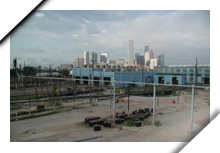Hardy Street Railroad Yard
SKA Consulting was retained by a private developer to conduct environmental investigation and remediation activities on and adjacent to an approximate 50-acre former railroad yard. The railroad yard was active from the late 1800s through the late 1990s.
Over 50 permanent groundwater monitoring wells and over 200 soil borings werecompleted on the property. Principal environmental issues identified on site included a phase-separated diesel fuel plume, chlorinated solvent groundwater plumes in two water-bearing zones, and widespread shallow soil contamination by lead, arsenic, and polycyclic aromatic hydrocarbons. SKA implemented soil and groundwater Remedial Action Plans (RAP) for cleanup of this property under the Texas Commission on Environmental Quality’s (TCEQ) Voluntary Cleanup Program. The cleanup of the property was completed to a residential land-use scenario utilizing TCEQ’s Texas Risk Reduction Program (TRRP). As part of this project, SKA also coordinated with insurance agencies that underwrote Cost Cap remediation, Pollution Legal Liability, and Preexisting Conditions insurance on the property. The Cost Cap insurance limits were based upon pro formaremediation estimates prepared by SKA and reviewed and approved by the insurance underwriter and third-party consultants.
The soil RAP specified excavation and off-site disposal of the contaminated shallow soils. Modeling of the soil contamination indicated excavation depth ranging from 0.5 to 7.0 feet. Contaminated soil areas were divided into 100 ft x 100 ft grids and sampled in-situ for waste disposal profiling using randomly selected sample locations. Approximately 120,000 cubic yards of soil was ultimately removed from the site. About 6,000 cubic yards of this soil was initially found to be hazardous for lead. This material was subdivided into smaller lots, re-sampled, and stabilized on-site with Portland cement to render it non-hazardous. A Response Action Completion Report (RACR) for soils was submitted to the TCEQ in November 2006. In February 2007, the TCEQ concurred that all response actions relating to soil at the site were complete for residential land-use.
The diesel non-aqueous phase liquid (NAPL) plume is approximately 650 feet long and extends over about 3.5 acres. A total of 17 recovery wells were installed for total fluids recovery using pneumatic pumps. Vacuum was applied to the wells to enhance fluid recovery. Recovered fluids were treated in an oil/water separator and the remaining water was polished with granular activated carbon prior to discharge to a permitted storm sewer. Over 80,000 gallons of diesel fuel were recovered prior to system shutdown in early-2006. The plume is currently being managed under a Plume Management Zone (PMZ) in accordance with the TCEQ’s NAPL PMZ guidelines.
The chlorinated solvent plumes in groundwater affect the upper and second water-bearing zones. Both plumes have been horizontally and vertically delineated, but the second water-bearing zone plume is approximately 2,000 feet long and has migrated off site. Each plume is being monitored for stability and natural attenuation within monitoring PMZs.
In April 2008, the TCEQ issued a Phased Conditional Certificate of Completion for residential land-use for this project site.

